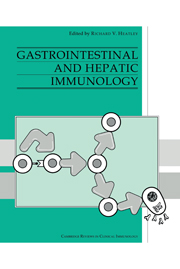Book contents
- Frontmatter
- Contents
- List of contributors
- Preface
- 1 Lymphoid cells and tissues of the gastrointestinal tract
- 2 Lymphocyte migration to the gut mucosa
- 3 Regulating factors affecting gut mucosal defence
- 4 Gastritis
- 5 The immunology of coeliac disease
- 6 Inflammatory bowel disease
- 7 Food intolerance and allergy
- 8 Gastrointestinal and liver involvement in primary immunodeficiency
- 9 Secondary immunodeficiency – the acquired immunodeficiency syndrome (AIDS)
- 10 Intestinal infections
- 11 Lymphomas
- 12 Small bowel transplantation
- 13 Clinical aspects of immunologically mediated intestinal diseases
- 14 Chronic active hepatitis
- 15 Primary biliary cirrhosis
- 16 Immunology and immunopathology of acute viral hepatitis
- 17 Immunology of liver transplantation
- 18 Clinical correlates with hepatic diseases
- Index
17 - Immunology of liver transplantation
Published online by Cambridge University Press: 03 February 2010
- Frontmatter
- Contents
- List of contributors
- Preface
- 1 Lymphoid cells and tissues of the gastrointestinal tract
- 2 Lymphocyte migration to the gut mucosa
- 3 Regulating factors affecting gut mucosal defence
- 4 Gastritis
- 5 The immunology of coeliac disease
- 6 Inflammatory bowel disease
- 7 Food intolerance and allergy
- 8 Gastrointestinal and liver involvement in primary immunodeficiency
- 9 Secondary immunodeficiency – the acquired immunodeficiency syndrome (AIDS)
- 10 Intestinal infections
- 11 Lymphomas
- 12 Small bowel transplantation
- 13 Clinical aspects of immunologically mediated intestinal diseases
- 14 Chronic active hepatitis
- 15 Primary biliary cirrhosis
- 16 Immunology and immunopathology of acute viral hepatitis
- 17 Immunology of liver transplantation
- 18 Clinical correlates with hepatic diseases
- Index
Summary
Introduction
The past three decades have witnessed the evolution of orthotopic liver transplantation from a pioneering procedure with a prohibitive mortality and morbidity to a standardised therapeutic measure for end-stage liver disease. Currently, one year survival for elective cases are often in excess of 80% with an excellent quality of life (Tarter et al., 1988). Equally important, long-term patient and graft survival in non-malignant cases, is excellent (Iwatsuki, Shaw & Starzl, 1985).
Issues in graft selection
ABO groups
The majority of transplant centres regard blood group compatibility as the prime immunological selection criterion. Transplantation of a liver from a donor with an incompatible ABO blood group is feasible, with well-documented reports of this being performed usually in urgent situations (Gordon et al., 1986). However, it soon became clear that results were quite poor, with a substantial number of grafts rapidly failing and requiring urgent re transplantation (Rego et al., 1987; Gugenheim et al., 1990).
On the other hand, transplantation of compatible but not identical livers is common practice, especially for recipients with the less common blood groups. Interestingly, the results of ABO identical grafts were slightly better than the ABO compatible but non-identical organs (White et al., 1987; Gugenheim et al., 1990). An occasional complication with compatible, non-identical grafts, is the occurrence of a form of graft-versus-host disease, where the immunocompetent passenger lymphocytes within the transplanted liver produce antibodies against the recipient erythrocytes.
- Type
- Chapter
- Information
- Gastrointestinal and Hepatic Immunology , pp. 354 - 365Publisher: Cambridge University PressPrint publication year: 1994

